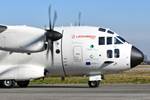Aernnova, Leonardo and AFuzion partner with Radia to build WindRunner
New aircraft is expected to deliver wind turbine blades from 105 meters up to expand the reach of wind energy and achieve global climate goals.
Three aerospace companies — Aernnova (Álava, Spain), Leonardo (Rome, Italy) and AFuzion (New York, N.Y., U.S.) — are partnering with energy company Radia (Boulder, Col., U.S.) on the 365-foot-long WindRunner aircraft, which is being developed to deliver some of the largest, most efficient wind turbine blades. Partners believe that the aircraft will expand the reach of wind energy, enabling the world to meet its climate goals.
Aernnova will develop the aircraft’s wing and engine pylons, while Leonardo will develop the fuselage. Both have extensive experience in composites. AFuzion will provide safety and certification consulting. Radia is reportedly targeting 2027 for entry into service (EIS).
The partnership agreement is the latest step forward for WindRunner, an aircraft designed to fly turbine blades up to 105 meters in length —and even larger ones of the future, what Radia calls GigaWind — directly to wind farm sites, landing on semi-prepared dirt runways as short as 1,800 meters.
It will overcome logistical barriers that today prevent the expansion of onshore wind energy, the partners explain. Wind turbines become more effective and efficient the larger they are — but long turbine blades are difficult and expensive to move by ground transport due to bridges, tunnels and road curves.
The result will be widespread availability of consistent, lowest-cost clean energy in more locations and at industrial scale for the grid, green fuel production including sustainable aviation fuel (SAF), and commercial power users such as data centers and hyperscalers. The market for onshore wind energy is estimated at up to $10 trillion by 2050 – with as many as 1 million wind turbines in service.
As reported by Omar Memon, in a March 2024 Simple Flying article, WindRunner’s fuselage length (108 meters) is longer than any other aircraft in history to accommodate not only today’s typical 70-meter-long blades but also future GigaWind blades up to 105 meters long. Its 8,200-cubic-meter payload capacity dwarfs the 1,160- and 610-cubic-meter capacity of the Antonov An-124 and Boeing 747-400, respectively, and it is expected to have a cargo bay volume that is seven times larger than the Antonov An-124. WindRunner will also feature a maximum payload weight of 72,575 kilograms.
Simple Flying reports that Radia will rely on efficient aerospace-grade materials, approved fabrication processes and proven technologies in order to meet its aggressive 2027 EIS, noting that mass production of the aircraft will be based on infrastructure similar to what already exists for large aircraft.
“WindRunner is an opportunity for the aerospace industry to have a decisive impact on climate change, diversify into the energy industry and seize an enormous market opportunity,” says Mark Lundstrom, Radia’s CEO.
“WindRunner must operate safely in a wide range of operating environments,” adds AFuzion CEO Vance Hilderman. “And the urgency of the climate crisis demands that it move systematically through the certification process so that it can enter into service. AFuzion is eager to bring our capabilities to bear to support WindRunner’s progress from design all the way through to deployment.”
Related Content
-
Plant tour: Daher Shap’in TechCenter and composites production plant, Saint-Aignan-de-Grandlieu, France
Co-located R&D and production advance OOA thermosets, thermoplastics, welding, recycling and digital technologies for faster processing and certification of lighter, more sustainable composites.
-
Plant tour: Arris Composites, Berkeley, Calif., U.S.
The creator of Additive Molding is leveraging automation and thermoplastics to provide high-volume, high-quality, sustainable composites manufacturing services.
-
CirculinQ: Glass fiber, recycled plastic turn paving into climate solutions
Durable, modular paving system from recycled composite filters, collects, infiltrates stormwater to reduce flooding and recharge local aquifers.






















